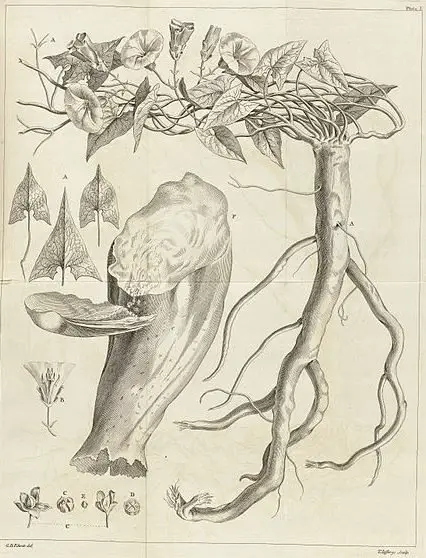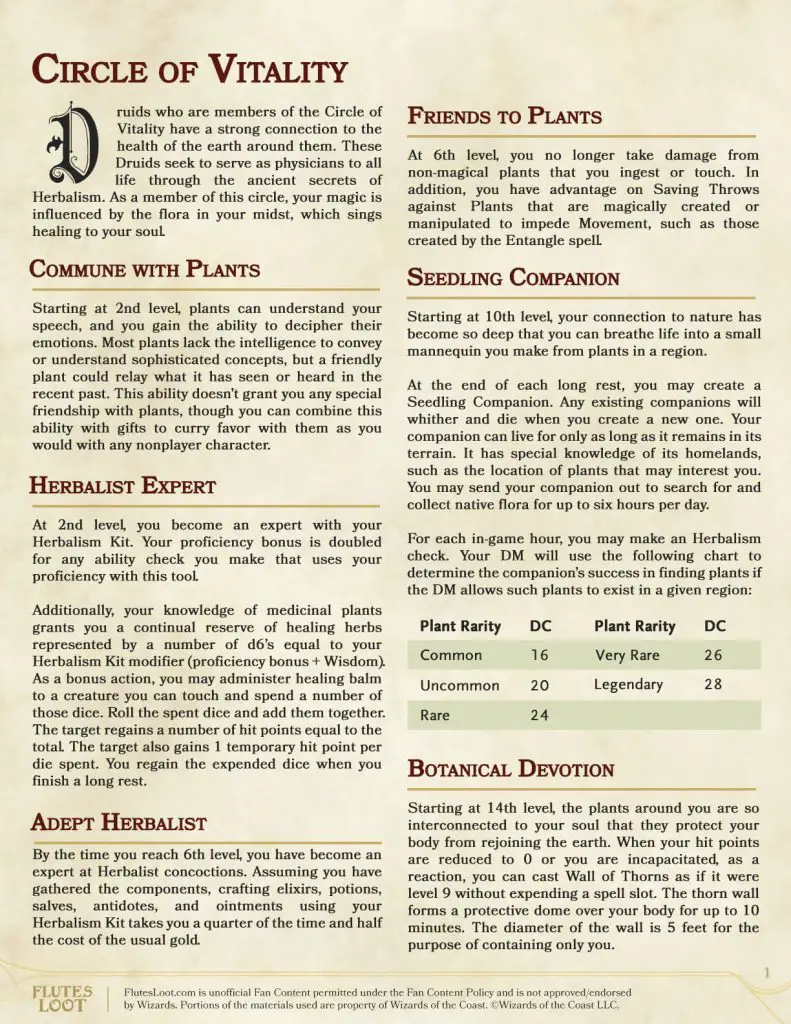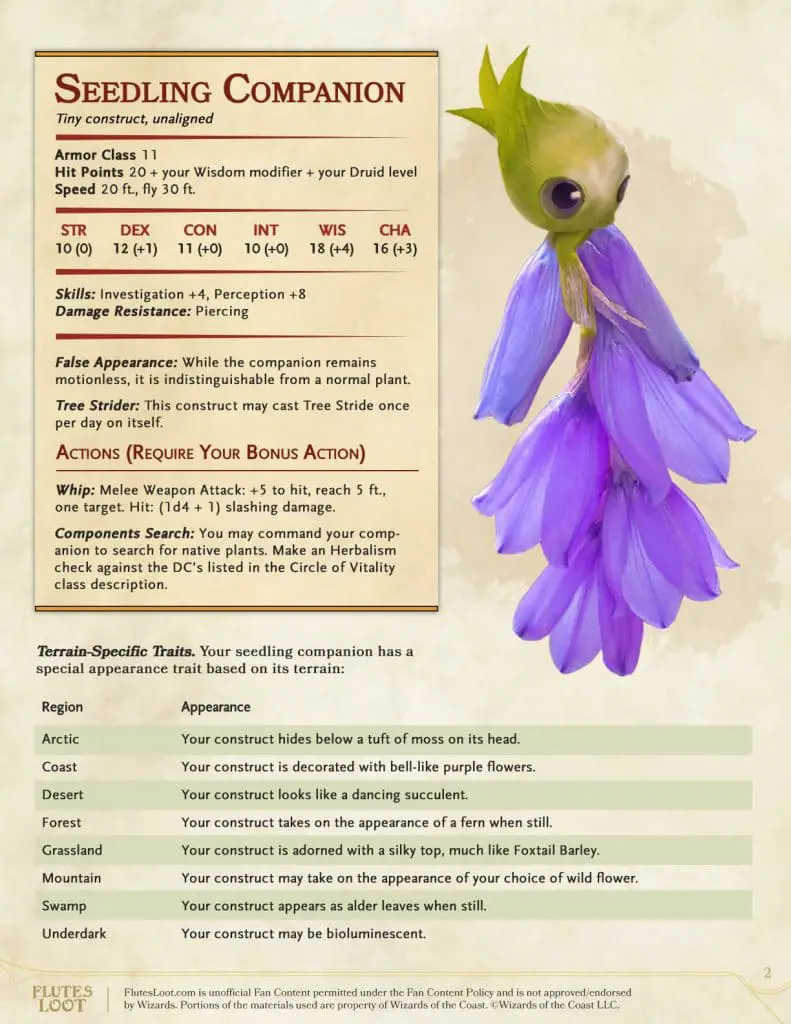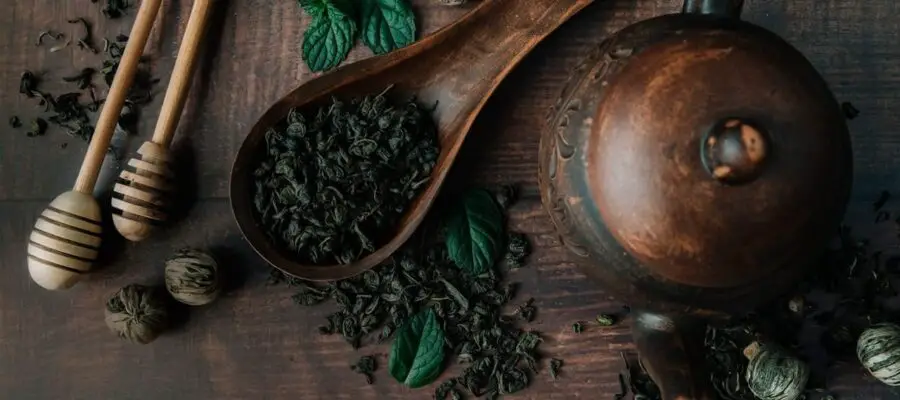Disclaimer: This article contains affiliate links that add gold to our coffers.
With the Eberron release of the Artificer class and the upward trend of crafting your own magic items using Xanathar’s Guide to Everything’s accommodating rules, Herbalism in your Dungeons and Dragons campaign has more uses than ever before. Not only can you create poultices, teas, ointments, elixirs, and balms, but a special organic material may be necessary for imbuing an item with magical properties.
For example, our formula for the magical item Reflex Boots requires a handful of dried Voidroot, which, according to the homebrew material Octavian’s Guide to Herbalism and Alchemy is a little difficult to extract:

Voidroot, component for Reflex Boots
“This dark grey thick root is often found amongst the most extreme environments. It normally grows in either desert or arctic environments and seems to vary in growth rate per root. Herbalists tend to be very careful when they extract this root from the ground, as it seems to defy gravity and want to ‘fly’ away.”
Image courtesy of Wellcome Images, CC License
So what do you, as a player, need to know about Herbalism?
The Herbalism Kit
An Herbalist must have an Herbalism Kit, which includes clippers, a mortar and pestle, pouches, and vials. With this kit, you add your proficiency bonus to ability checks made to identify or apply herbs, and is necessary to create antitoxins and potions of healing. The cost is 5gp and weighs 3 pounds.
Xanathar’s Guide to Everything further clarifies that the kit includes “pouches to store herbs, clippers and leather gloves for collecting plants, a mortar and pestle, and several glass jars.”
A Poisoner’s Kit may also be a wise tool proficiency. Luckily, the Artificer can choose a myriad of tools to be proficient with!
Knowledge of Plants
Herbalism as a skill isn’t a direct choice in 5e in that there is no canonical Herbalism skill. Rather, to be a good herbalist, a player may wish to hodgepodge certain proficiencies together to round out her skills: Arcana for knowledge of how to apply plants and creatures in magical studies; Investigation or Perception for finding plants and ingredients in overgrown or unobvious areas; Medicine for using medicinal plants to heal; and Nature or Survival to identify poisonous plants.
Xanathar’s Guide to Everything (page 82) does a superb job of improving the Herbalism Kit proficiency to include these skills off-the-record (as in, you don’t actually fill in the bubble for these skills, but the Herbalism kit makes up for it!):
“Proficiency with an herbalism kit allows you to identify plants and safely collect their useful elements.
Arcana. Your knowledge of the nature and uses of herbs can add insight to your magical studies that deal with plants and your attempts to identify potions.
Investigation. When you inspect an area overgrown with plants, your proficiency can help you pick out details and clues that others might miss.
Medicine. Your mastery of herbalism improves your ability to treat illnesses and wounds by augmenting your methods of care with medicinal plants.
Nature and Survival. When you travel in the wild, your skill in herbalism makes it easier to identify plants and spot sources of food that others might overlook.
Identify Plants. You can identify most plants with a quick inspection of their appearance and smell.”
Gathering Ingredients
The whole point of having an Herbalism Kit as a tool proficiency is so that you can add your proficiency bonus to Herbalism checks for gathering ingredients. Your proficiency in this might also help you know where to find the plant, including terrain, time of day, season, associated challenges, et cetera. Your character can passively search for ingredients in your adventure, but be sure to let your DM know. Couple this skill with a high Wisdom so that your passive perception is quality enough to spot desired plants.
Applying Herbalism In-Game
As a player or a DM, you’ll need some creativity in creating formulas for magic items. There are many resources online, including our Artificer’s Field Guide (free to download!) that describes magical and non-magical ingredients, their effects, the terrain found in, their rarity, and further extraction notes.
For example, from our Field Guide, you may find that Calcena is useful for medicine checks:
Calcena is a small pink-brown mushroom. Anyone who breathes the spores too much will hallucinate for a few minutes. On the other hand, meticulously mixed with oils, one draws a vivifying cream which helps to heal more quickly.
Applying the cream of calcena on the lips of a dying person gives the advantage to the first roll of Wisdom (Medicine) made to stabilize the subject.
If you are a player, talk to your Dungeon Master about what you need to do to create formulas, or how you can discover them in-game. Let them know what you’re interested in and the resources you have found that might make that possible.
As a Dungeon Master, you can imbue your Herbalism-loving players with knowledge of formulas through sage NPCs, old books, accidental discovery, or allow them to create formulas through their own ingenuity. See our non-canonical ideas on how to help your players role play crafting magic items, including developing herbalistic concoctions.
Playable Options
The Artificer may be one of the strongest classes to play for an Herbalist, but a few other options suit it well, including Druid, Cleric, Wizard, and Ranger.
Flutes Loot Exclusive Homebrew

Druids who are members of the Circle of Vitality have a strong connection to the health of the earth around them. These Druids seek to serve as physicians to all life through the ancient secrets of Herbalism. As a member of this circle, your magic is influenced by the flora in your midst, which sings healing to your soul.
Commune with Plants
Starting at 2nd level, plants can understand your speech, and you gain the ability to decipher their emotions. Most plants lack the intelligence to convey or understand sophisticated concepts, but a friendly plant could relay what it has seen or heard in the recent past. This ability doesn’t grant you any special friendship with plants, though you can combine this ability with gifts to curry favor with them as you would with any nonplayer character.
Herbalist Expert
At 2nd level, you become an expert with your Herbalism Kit. Your proficiency bonus is doubled for any ability check you make that uses your proficiency with this tool.
Additionally, your knowledge of medicinal plants grants you a continual reserve of healing herbs represented by a number of d6’s equal to your Herbalism Kit modifier (proficiency bonus + Wisdom). As a bonus action, you may administer healing balm to a creature you can touch and spend a number of those dice. Roll the spent dice and add them together. The target regains a number of hit points equal to the total. The target also gains 1 temporary hit point per die spent. You regain the expended dice when you finish a long rest.
Adept Herbalist
By the time you reach 6th level, you have become an expert at Herbalist concoctions. Assuming you have gathered the components, crafting elixirs, potions, salves, antidotes, and ointments using your Herbalism Kit takes you a quarter of the time and half the cost of the usual gold.
Friends to Plants
At 6th level, you no longer take damage from non-magical plants that you ingest or touch. In addition, you have advantage on Saving Throws against Plants that are magically created or manipulated to impede Movement, such as those created by the Entangle spell.
Seedling Companion
Starting at 10th level, your connection to nature has become so deep that you can breathe life into a small mannequin you make from plants in a region.
At the end of each long rest, you may create a Seedling Companion. Any existing companions will whither and die when you create a new one. Your companion can live for only as long as it remains in its terrain. It has special knowledge of its homelands, such as the location of plants that may interest you. You may send your companion out to search for and collect native flora for up to six hours per day.
For each in-game hour, you may make an Herbalism check. Your DM will use the following chart to determine the companion’s success in finding plants if the DM allows such plants to exist in a given region:
| Plant Rarity | DC against Herbalism check |
| Common | 16 |
| Uncommon | 20 |
| Rare | 24 |
| Very Rare | 26 |
| Legendary | 28 |

|
Seedling Companion
Tiny Construct, unaligned |
|||||||
|
Armor Class: 11 |
|||||||
|
|||||||
|
|
|||||||
|
Skills: Investigation +4, Perception +8
False Appearance: While the companion remains motionless, it is indistinguishable from a normal plant. Actions
Whip: Melee Weapon Attack: +5 to hit, reach 5 ft., one target. Hit: (1d4 + 1) slashing damage.
Terrain-Specific Traits Your seedling companion has a special appearance trait based on its terrain:
Arctic: Your construct hides below a tuft of moss on its head |
Botanical Devotion
Starting at 14th level, the plants around you are so interconnected to your soul that they protect your body from rejoining the earth. When your hit points are reduced to 0 or you are incapacitated, as a reaction, you can cast Wall of Thorns as if it were level 9 without expending a spell slot. The thorn wall forms a protective dome over your body for up to 10 minutes. The diameter of the wall is 5 feet for the purpose of containing only you.
Additional Resources
- Download our Artificer’s Field Guide for a list of about 500 components for herbalism and alchemy, including descriptions, effects, rarity, where to find them, and more.
- ForgottenAdventures by Shaun Hately has many herbs in a given region with specific properties.
- The Forgotten Realms Fandom has a robust list of plants used in our fantasy setting.
- ZeroHitPoints has compiled a list of herbs from Middle Earth for our edification.
- Of course, Octavian’s Guide to Herbalism & Alchemy is wonderful for our purposes.
- RealmsHelps has Alchemy resources from the 3.5 edition of D&D.
- Shaun Hately has compiled a guide: The Guide to RPG Herb Use
- Avalon-RPG gives a wonderful list of herbs and their rough effects.
- Redditor NeurotoxinNihilist put together several documents for fantasy plants.
You might enjoy this Alchemist class by Taron “Indestructoboy” Pounds. Here Flutes’ review of it:





What is the DC (13) Modifier column in the Field Guide?
Hi Matt! If I understand your question correctly, the DC (Difficulty Class) is the target number for the Herbalism skill check required to extract the plant/component. A player can roll an Herbalism (or Poison) check, and will have a success when their roll equals or beats that DC. The DC listed is just a general guideline for if a DM wanted to attach a skill check with obtaining the plant. I hope this helps!